The Project Gutenberg eBook, Big People and Little People of Other Lands, by Edward R. Shaw
BIG PEOPLE
AND
LITTLE PEOPLE
OF OTHER LANDS
BY
EDWARD R. SHAW
Dean of the School of Pedagogy
New York University
New York Cincinnati Chicago
American Book Company
1900
CONTENTS
| Preface |
| China |
| Japan |
| Arabia |
| Korea |
| India |
| Lapland |
| Greenland |
| Russia |
| Switzerland |
| Holland |
| Patagonia |
| The Pygmies |
| The Indians |
| The Philippine Islands |
| Bangala |
| The Amazon Valley |
PREFACE.
This little book is designed to meet the child's natural desire to learn or hear of other people than those living in the part of the world about him.
It has been thoroughly proved in our newer pedagogical practice that the child in the first school year is much interested in descriptions of the Indian and the Eskimo. Whenever descriptions of the Indian and the Eskimo have been given him, they have not only fulfilled their purpose in furnishing material for reading and the interrelation of several activities of expression, but they have revealed to him the fact that there are other people in the world, who differ very much from those he has seen.
His interest in different peoples at this time is in their physical appearance, their dress, their ways of living, their customs, their manners, and it arises chiefly from the contrast which descriptions of these afford to familiar customs, conditions, and physical characteristics.
The child is not interested, at that stage of his intellectual development which falls in the first or the second school year, in the situation of countries. It does not matter to him exactly where, geographically, the people about whom he reads live. He is satisfied if some general statement is made to the effect that they live far away to the north, where the cold countries are, or in the south, where it is warm and sometimes hot, or on the other side of the world.
His desire, at this period, for new impressions and ideas gained from
descriptions and accompanying pictures is as keen as his desire for
sense impressions gained from the world of nature and activity about
him. This wider range of information and ideas, it is believed, he may
in some measure gain from this little book.
DRESDEN, July 15, 1899.
PEOPLE OF OTHER LANDS.
CHINA.
On the other side of this great round world is a country called China. When it is dark here, and we are going to sleep, the sun is just waking up the children in China and telling them it is morning. When we get up in the morning they are just bidding the sun good night. When it is light here it is dark there. So they have day when we have night.
Chinese children look like little men and women, for they dress like their fathers and mothers. Boys and girls dress nearly alike. They both dress in silk or cotton trousers. They wear over these long gowns reaching nearly to their feet. They wear odd-looking shoes with thick white soles. The boys' heads are shaved, except a small part on top. There a lock of hair is left. This lock of hair is braided and hangs down the back. A queer name is given to it. It is called a "queue." Girls in China do not go to school, but all day long they are busy; they help their mothers keep house; they tend the babies; they sew, and help with the cooking.
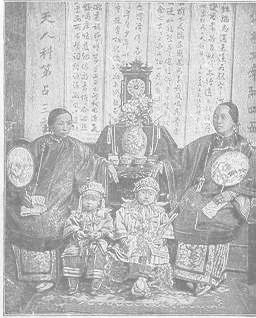
[Illustration: Chinese Women and Children.]
The schools in China are only for boys. The boys make a great deal of noise in school. A Chinese teacher thinks the boys are idle if they do not study their lessons out loud. So each boy shouts as loud as he can. When the boy has learned his lesson, he goes up and gives his book to the teacher. Then he turns his back to the teacher, and shouts out the whole lesson to show that he knows it.
The boys are taught to count. They learn by using balls set in a frame. The frame is like the frame of a slate. The balls slide on wires. With the balls they learn to add and subtract.
They also learn how to write, but they have no pens or pencils. They write with small brushes dipped in ink. Each boy makes his own ink. He puts some water on a stone and then rubs a cake of ink in the water. This makes a fine black ink called India ink. Then the boy fills his brush and begins at the top, right-hand corner of the paper. He writes toward the bottom of the sheet. He puts one word under another instead of beside it as you do. Then he begins a new line at the top, and writes to the bottom again.

[Illustration: Chinese writing.]
Chinese books are printed in the same way. Where do you think a Chinese book begins? A Chinese book begins where our books end.
In China many girls and women have very small feet. When they are babies their feet are bound up tightly. They sometimes wear iron shoes. Then their feet never grow, but are so very small that they can hardly walk. Poor parents know their girls will have to work hard, and so do not bind their feet.
Chinese girls make beautiful paper flowers. They paint pictures. They sing and play. Some of them pick the snow-white cotton in the fields. Some of them take care of the silk-worms that spin the soft silk.
But they do not work all the time. They play many pretty games. Chinese boys, too, have many kinds of games and toys. One game is like battledoor and shuttlecock. They use their feet to strike the shuttlecock. They do this so fast that the shuttlecock hardly ever falls to the ground. The Chinese are fond of flying kites. Even old men fly kites. They fly their kites in the spring-time. Chinese kites are of all sizes and shapes. Some are like birds. Some are like fish. Some are like butterflies.
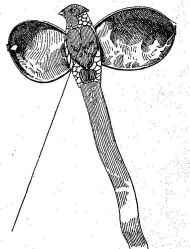
[Illustration: Chinese Kite.]
There is no other such land in all the world for lanterns as China. The lanterns there are made of paper in the shape of balls, or flowers, or animals. Some of the lanterns have a wheel inside. When the candle is lighted, the draft of air makes the wheel go round very quickly. When the wheel begins to move inside, the figures on the outside of the lantern begin to move. Then men are seen fishing or fanning. Sometimes children are seen dancing.
The Chinese are so fond of lanterns that every year they have a "Feast of Lanterns." On that day and night lanterns are to be seen everywhere. Bridges and houses and trees are covered with lighted lanterns.
They have fireworks, too, that look like stars and trees and flowers.
A Chinese dinner begins in the wrong way. They have fruits and nuts first. After this comes rice. They eat more of rice than of anything else. Then they drink tea without either milk or sugar. They use neither forks nor knives. Instead they eat with small sticks of wood or ivory. These are called "chopsticks." They hold them between the thumb and first two fingers. They use them to carry their food to their mouths as you use a fork or a spoon.
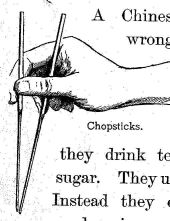
[Illustration: Chopsticks.]
Do you know how they catch fish in China?
They have a bird which swims and dives into the water. This bird lives on fish. Every time he dives he catches one. He is trained to bring the fish to his master. A tight ring is put round the bird's neck. This is to keep him from swallowing the fish. When enough fish have been caught, the bird is given some to eat. This bird is called a cormorant.
A Chinese fisherman lives in his fishing boat. But China is a very crowded country. So other men as well as fishermen live on small flatboats in the rivers near the big towns. Ducks and other fowls are raised on these boats. The people on the water are as busy as the people on the land.
In China houses are one story high. They are built of wood. The roofs slope, and are made of sticks woven together. The churches are called pagodas. They are not like our churches, but are tall, like towers. They are usually nine stories high. They have little bells hung all around the roof. These bells ring when the wind blows them back and forth.
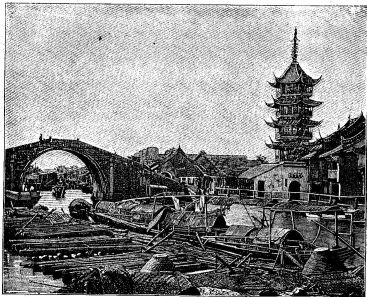
[Illustration: Chinese Boats and Pagoda.]
Between the houses are narrow streets without sidewalks. There are no wagons. If a lady goes to make a call, she sends for a sort of covered chair. This has long poles on each side. The chair is set on the ground before her door. After she gets in, men lift the poles to their shoulders. In this way they carry her. Baggage and heavy articles are also carried on the shoulders of men.
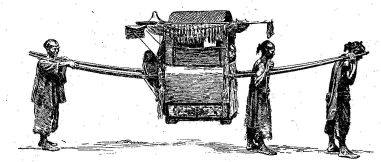
[Illustration: Covered Chair with Poles.]
But perhaps the most wonderful thing in China is the Great Wall. It was built by kings a long time ago. They wanted to keep savage people from coming into the country. The wall is built very high and very wide. It is so wide in some places that eight horses can be driven on top of it side by side. It is hundreds of miles long. The people of China think it is very wonderful. They think there is nothing so wonderful in all the rest of the world.
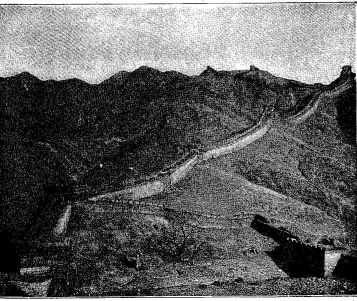
[Illustration: The Great Wall.]
China seems a curious country. Boys shout out loud in school. They read and write backward. Men fly kites, like boys. Women have feet as small as babies' feet. At dinner nuts and fruits are eaten first. Men work like animals. There are many ways in which the Chinese are different from the people in our country.
JAPAN
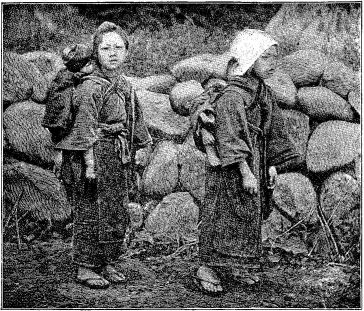
[Illustration: Japanese Children.]
How would you like to ride in a wagon drawn by a man instead of a horse? That is the way people ride in Japan. Japan is a country a long way off, near China. You would think that a man could not run very fast drawing a wagon. But in Japan some men can run as fast as horses. The wagon is like a buggy, but it has only two wheels. They call this wagon a jin-rik'i-sha.
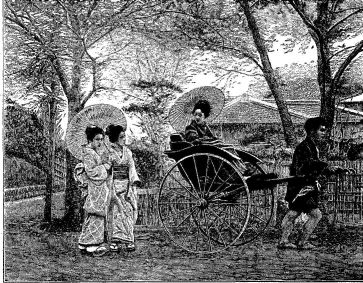
[Illustration: A Jinrikisha.]
The streets in Japan have no sidewalks. The houses are only one or two stories high. They are built of wood. They have no windows or doors. Strange houses, you will think. The walls outside and inside are made like sliding doors. They slide back so that the people can go in and out, and from one room to another.
The Japanese have very little furniture in their houses. They have no chairs. They do not need any, for they sit on cushions on the floor. They also sleep on the floor. When it is time to go to bed, they spread soft quilts on the floor, one over the other. The last quilt on the top is the cover. These beds are very nice. But you could never guess what kind of pillows they have. The pillows are blocks of wood the size of a brick. You would not think them nice at all. But the Japanese seem to sleep very well on their wood pillows.
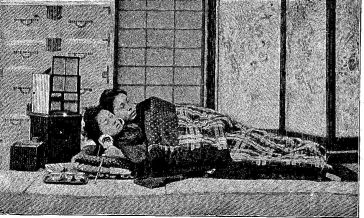
[Illustration: A Japanese Bed.]
Many of the things in the houses in Japan are made of paper, They have paper fans, paper lanterns, paper hats, paper cups, paper umbrellas, paper napkins, and paper screens.
They have no stoves. Instead of stoves they have boxes lined with brass. In these boxes they burn charcoal to heat their rooms. But they do not cook their food in these brass boxes. They cook in little ovens made of clay.
When it rains in Japan the people look very funny. The men wear rain coats made of rice straw. They also have big straw hats and paper umbrellas.
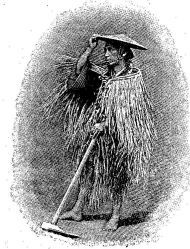
[Illustration: A Rain Coat.]
They wear blocks, three inches high, fastened to the soles of their shoes. These keep their feet dry. So on a rainy day everybody looks three inches taller.
In Japan they do not wear shoes in the house. When they go into their houses they take them off. Their shoes are made of wood or straw. Some of the people have shoes with gold braid.

[Illustration: Japanese Shoes.]
Perhaps you would like to know how they dress in Japan. Boys and girls dress very much alike. Both wear long gowns, like skirts, of blue or gray cotton or silk. These gowns are open at the neck. A sash is worn around the waist. The girls tie their sashes in a bow at the back.
The children of Japan are very strange looking, not at all like you. They are like the Chinese. Their skin is yellow, and their eyes are slanted. Their hair is black and straight.
You will wish to know what they eat in Japan. The food is much the same as in China. They eat a great deal of rice. They have fish, and they drink tea. They use chopsticks in eating, as the people in China do.
The people in Japan are very fond of flowers. Every house has a garden around it. The boys and girls walk and play in these gardens.
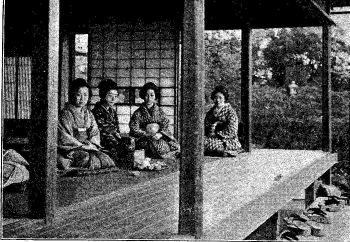
[Illustration: Interior of a Japanese House.]
Boys and girls in Japan have many nice toys. One of their toys is a little oven with real fire in it. Peddlers go round with these ovens and with sweet dough to bake in them. For five cents the boys and girls can get the use of an oven, and dough enough to bake little cakes. They often make cakes shaped like animals. The peddler makes the letters of the alphabet in dough. Then he bakes them in the oven for the boys and girls. With these cake letters they often learn their a, b, c.
The boys in Japan, like the boys in China, are very fond of kites. But in Japan they have fighting kites. They mix broken fine glass with glue, and rub it on their kite strings. When the strings become dry they are hard and sharp. Then the boys fly their kites. One boy tries to cross and cut the string of another boy's kite with the string of his own. The boy who cuts down a kite gets it as his prize.
In Japan they have a day like our Flag Day. On this day the boys have toy soldiers with swords and guns. They form these soldiers into armies, and have battles. Then the parents and teachers tell the boys about the great soldiers of their country, and the great battles they fought.
The girls have a day for themselves. They call it the "Feast of Dolls." Every girl has a set of dolls. On that day they take out their dolls and doll houses. Then the girls play with them, and show them to one another.
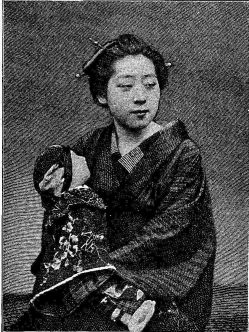
[Illustration: Japanese Girl and Doll.]
They have schools in Japan just as we have. The boys and girls must go to school until they are ten years old. Some of their lessons are very hard. They have forty-seven letters in their alphabet, instead of only twenty-six, as we have. Don't you think it must be hard for the boys and girls to learn to read?
They go to school very early in the morning. Before they enter the school they take off their shoes. When the teacher comes, they bow down their heads nearly to the ground and draw in their breath. This is their "good morning." The teacher also bows to the boys and girls.
Then the children sit on the floor. They put their books on their knees and begin their lessons. They have no pens or pencils. They use little brushes instead. They write in lines from the top to the bottom of the sheet of paper, instead of across from side to side as we do. This is the way, you remember, they write in China. The books in Japan are also like the books in China. The last page in our books would be the first page in books in China and Japan. So their books begin at what we would think the end. How queer this seems to us!
There are newspapers in Japan, but they are not much like ours. The lines run up and down just as Japanese writing does. They read back from what we would call the last page.
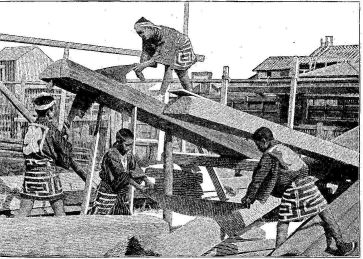
[Illustration: Japanese Carpenters at Work.]
A great many things that we use in America come from Japan. We get silk from Japan, and beautiful vases and mats and screens and basket work. The boys and girls in Japan help to make these things. For they are bright and learn quickly how to do very nice work.
ARABIA.
Have you ever heard of the Arabs? They are people with brown skin and dark eyes. They live in a country called Arabia. It is a very warm country. There is never any snow in Arabia. A great part of it is covered with sand. For miles and miles you would see nothing but sand. Often the sand is so hot that you could not walk on it in your bare feet. Those great tracts of sand are called deserts.
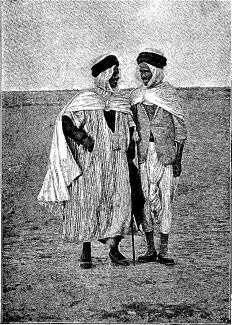
[Illustration: Arabs.]
In many parts of Arabia water is very scarce. It rains very seldom, and in some places there are no rivers. The people get water out of wells. They carry the water, in bottles made of leather. Glass bottles would not do. The heat is so great that it would go through the glass. Tins would make the water warm. But the leather bottles keep the water cool.
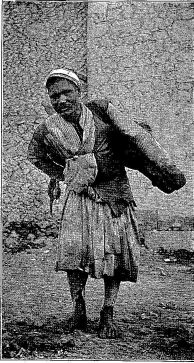
[Illustration: Arab Water Carrier.]
Some of the Arabs live in towns. They have walls around their towns. At some parts of the walls there are towers. Both walls and towers are made of earth.
In every large town they have an open market place with shops around it. In most of the shops they sell food. In a few of the shops they sell cotton cloth and other dry goods. Many of the shops are kept by women.
The streets are swept every day. Every family sweeps the street in front of its own door.
The houses in the towns are made of stone. They have flat mud roofs and small windows. The Arabs have no chairs or beds in their houses. They sit on mats or carpets spread on the floor. They also sleep on mats.
The chief room in an Arab house is the coffee room. It is a large room with a furnace or fireplace at one end of it for making coffee.
Many of the Arabs live in tents. They move about from place to place. Sometimes they cross the desert to come to the towns. They must often cross it to find water and grass for their horses and camels and sheep.
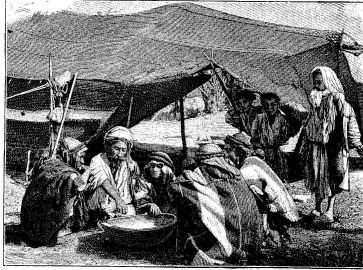
[Illustration: Arabs and Tent.]
The camel is very useful to the Arabs. Perhaps you have seen a camel. It is much larger than a horse. It has a great hump on its back. It has large feet with broad, flat soles; and it can walk or run over the sand without sinking.
The camel can carry a very heavy load. It gives milk which is good to drink. Its hair is made into cloth. Its flesh is good meat. It can bear thirst and heat far better than a horse can. It can travel and carry a load in the desert for three or four days without drinking. This makes it very useful to the Arabs.
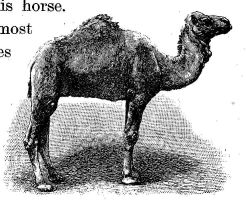
[Illustration: A Camel.]
But the Arabs have horses also. They are the finest horses in the world. An Arab is very proud of his horse. He loves him almost as much as he loves his children.
Did you ever hear the story that is told of Hassan and his horse? Hassan was an Arab who had a horse which he loved very much. And the horse loved Hassan very much.
One day Hassan was riding on his horse in the desert with some other Arabs. They were met by a party of men called Turks, who made them prisoners. The Turks tied the feet of Hassan and his friends with leather straps. They tied the horses also. They planned to carry them off next morning.
During the night Hassan heard his horse neighing. He crept up to him and said in a low voice: "What will become of you, my poor horse? You will not be happy with these Turks. Go home to my tent. Tell my wife that she will never see me again. Lick the hands of my children with your tongue, as a token of my love."
He then bit off with his teeth the cords that tied the horse, and set him free. The horse looked at his master for a minute or two. Then he caught him with his teeth by the belt and ran off with him into the desert. On and on across the sand he ran. He never stopped until he had laid Hassan down beside his wife and children. Then, worn out with his long run, he dropped dead at his master's feet.
All the people around wept when they heard the story. Arab poets made songs about Hassan and his horse.
The Arabs do not eat very much. Their chief meal is supper. They have supper in the evening. They are very fond of coffee. Did you ever hear of Mocha coffee? It comes from Mocha, a town in Arabia. Most of the Arabs take their coffee without sugar or milk.
They always make their bread in thin cakes. Then they bake the bread on hot iron plates or in an open oven. They also have ground wheat cooked with a little butter. Arabs who are rich have mutton or camel's flesh, and also rice. All eat vegetables and fruits of various kinds.
There are many kinds of fruit in Arabia. But the greatest and best of all is the date. This grows on the date-palm tree. The date palm grows very high. The Arabs are very proud of it. Every part of it is of use to them. Its fruit is the chief food of many of the people. You have seen and perhaps you have eaten dried dates. They are not nearly so sweet or so good as the fruit when taken off the tree. The trunk of the date palm is good for making furniture. Its leaves make roofs for houses. Parts of its branches make firewood. From some parts of the tree cords and ropes are made.
The Arabs do not wear very many clothes. They do not need heavy clothes, because the weather in Arabia is almost always very warm. The men wear long light dresses like shirts. They have a belt, or girdle, around the waist. They wear a handkerchief on the head. This is tied around with a band or string. On their feet they wear sandals. Do you know what a sandal is? It is a shoe with only a sole, and straps going across the foot and round the ankle. The Arab women also wear a long shirt. Over it they have a large, wide piece of blue cloth. This blue cloth covers them from head to foot.
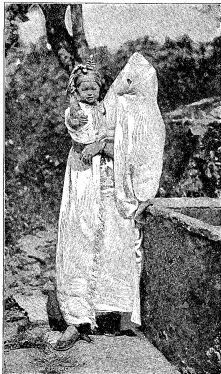
[Illustration: Arab Woman and Child.]
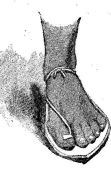
[Illustration: An Arab Sandal.]
But what about the Arab boys and girls? What do they wear? Most of the boys run around without shoes or stockings. But some of them wear little red shoes turned up at the toes, and others wear small sandals. They also wear loose trousers and jackets and little red caps. The girls commonly wear cotton dresses that are made very plain. Sometimes they have veils over their heads. In the country places the girls do not wear veils.
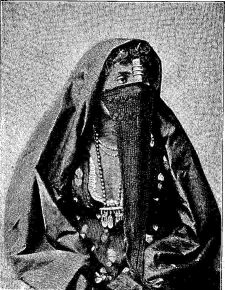
[Illustration: Arab Girl with Veil.]
Only the boys go to school. Before they enter the school they must take off their sandals. They have no seats in their schools. They all sit on the floor. Their lessons are not like your lessons. They have only one book. It is called the Koran. The Koran is the Arab Bible. The Arab boys must learn the Koran by heart. At school, they all shout out together when they are learning their lessons.
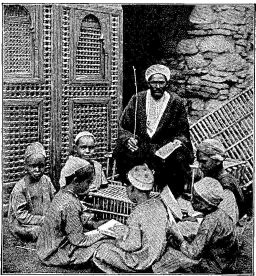
[Illustration: A School in Arabia.]
But the Arab boys learn many things at home. They learn to read and to write. They also have plenty of time to play. They play ball. They fly kites. They ride ponies. Often they play with old guns and swords. Thus they learn to be soldiers.
The Arab girls do not go to school. But they do not play very much. They must help their mothers do the work at home. The mothers grind corn to make bread. They spin and weave cloth for clothes. They grind the corn with two flat stones. One of these stones is placed on top of the other. There is a hole in the middle of the upper stone. They pour the corn into this hole. The upper stone is then turned round by a handle. So the corn is ground between the two stones. The girls often have to turn the stone around. They must also take care of the baby. They help to carry home water from the well. They carry the water in earthen jars.
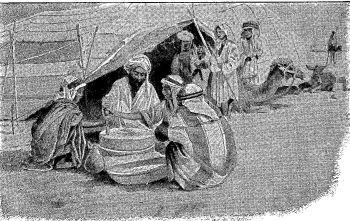
[Illustration: Arabs Grinding Corn.]
You will say, then, that the Arab girls have a hard time. But they do not work always. They have some time for play. They have very funny dolls. Would you not laugh if some one gave you two sticks joined like a cross, and told you it was a doll? That is the kind of doll the Arab girls have. And they are very fond of their dolls. They dress them, and take great care of them.
The Arabs are very fond of tales and stories. Perhaps you have heard of a book called the "Arabian Nights." It is full of wonderful stories about kings and giants and witches, and other strange things. This book came from Arabia. When you are older you will read the "Arabian Nights." In it you will learn many more things about Arabia and the Arabs.
KOREA.
What funny hats they wear in Korea!
But, you will ask, where is Korea? It is near Japan, a country you have read of in this book.
The people of Korea look a little like Chinamen. They have yellow skin and slanting eyes. Their hair is long, straight, and black, and they wear it in a very strange way. The boys and girls wear their hair down their backs in braids tied with ribbons. The men and women have their hair in little topknots that stand straight up.
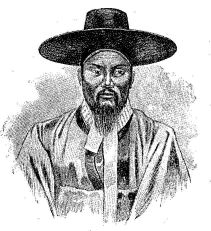
[Illustration: A Korean.]
But I must tell you about the strange hats they have. Some of the men wear hats that go down over their shoulders. This is the kind of hat they wear when they are in mourning, after the death of a father or mother. Some wear hats made of straw. These hats look like large flowerpots turned upside down. Some have hats made of horsehair.
But the hats made of straw and the hats made of horsehair do not keep the rain out. So they have umbrellas. Their umbrellas are as funny as the hats. They are made of oil paper, and have no handles. They look like fans. When it rains, the people open their umbrellas and tie them on top of their hats.
The boys in Korea wear loose jackets, and wide trousers which go under their stockings. The stockings are padded with cotton, and are tied at the ankle. The girls wear very pretty little jackets, sometimes red, sometimes pink, and sometimes green.
The shoes they wear in Korea are of many kinds and shapes. Some are made of leather. Others are like the wooden shoes the Chinamen wear, which turn up at the toes. The funniest shoes they have are made of paper. The paper is very thick and strong, and so their paper shoes last a good while. But the shoes that are worn by most of the people in Korea are made of straw. They are like sandals, and they are worn so that the large toe is not covered.
The people in Korea have a strange way of keeping themselves cool in hot weather. They have something like a basket made of rods of bamboo. This basket is round and long, and open at the top and bottom. They put their heads through this basket, and it hangs downward from their shoulders around their bodies. Then they put their clothes over it, so that the basket is inside. It is next to their skin. How would you like to have such a summer dress?
The boys in Korea go to school when they are very young. The girls do not go to school. They stay at home to help their mothers. But girls whose parents are rich have teachers at home to teach them reading and writing and other things.
In school, the teacher sits on a straw mat on the floor. The boys also sit on the floor on straw mats. They say their lessons out loud. They write their lines from the top to the bottom of the page. The people in China and Japan, as you know, write in the same way. The boys of Korea learn to count on a _chon-pan_. The chon-pan is much like the counting box they have in the schools in China. It is made of little balls on a frame of wires fixed in a box. The boys also learn by heart the wise sayings of great men.
The boys in Korea have some very nice toys. But the best playthings they have are their kites. They make their kites fight battles in the air, just as the boys do in Japan. Every boy tries to tear down every other boy's kite. This is done by pulling the strings across one another. Sometimes the sky is full of beautiful kites, which jump and dash about as if they were alive.
The boys also have fine, large pinwheels. They make these pinwheels whirl around in the wind. The boys also spin tops, and they play "seesaw," and jump the rope.
The boys in Korea are fond of fishing. Nearly every boy has a fishing rod and goes fishing whenever he can. Sometimes the boys have great fun going around dressed like their fathers. They wear wooden swords and little bows and arrows like soldiers. They make straw figures of men, and with their swords they strike off the heads of these straw men.
But the boys have to work as well as play. Many of the peddlers in Korea are boys. They sell candy and other things. The girls do a great deal of work at home. The first thing they learn to do is to sew.
Would you like to know how the women iron their clothes? They wrap each piece around a stick and lay it on the floor. Then they sit down and beat the piece on the stick with wooden clubs. In this way they make the clothes as smooth as a Chinaman makes the linen which he irons.
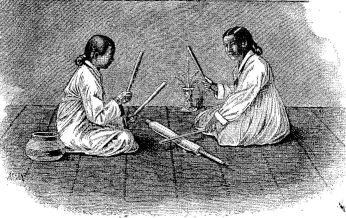
[Illustration: Korean Girls Ironing Clothes.]
The houses in Korea are one or two stories high. They are made of wood or clay, and sometimes the roofs are of straw. The windows are high, and the doors are often so low that the people have to stoop down to go in. The rooms are very small and have hardly any furniture. There are no chairs. The people sit on mats on the floor. The walls between the rooms are made of paper, and the floor is made of stone.
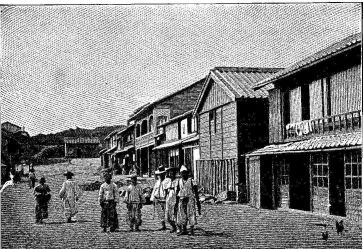
[Illustration: Korean Houses.]
They have a strange way of heating their houses. They have no stoves or fireplaces. But under the floor they have a cellar like an oven. In this cellar a fire is always kept, and the rooms are sometimes so hot that the people can hardly walk on the stone floors.
People who are poor sleep on mats on the floor. They sleep in their clothes. People who are rich have mattresses. The mattresses are laid on the floor at night, and are taken up in the morning.
The people of Korea eat a great deal of rice. But they have other kinds of food. They have meat and fish and eggs and also fruit. You would think that they would use a great deal of tea, as they live so near China. But they do not drink tea. They drink rice water instead. The rice water is water that rice has been boiled in.
At their meals the men always eat first and the women wait on them. When the men have eaten as much as they want, then the women and children eat.
The tables they have are very low. It would not do for them to have high tables, as they sit on the floor.
They have no knives or forks. They eat with spoons, and they use chopsticks, as the Chinamen do.
They have no water-pipes in their houses. In the towns men carry water in pails. They have no gas. For light at night they use candles.
They have only one kind of coin. It is a small piece of copper. It has a square hole in the middle. They put these coins on strings and carry them around their necks. It would take many such coins to make a dollar.
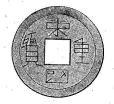
[Illustration: Korean Money.]
There are farms in Korea, where they grow wheat, rice, rye, tobacco, cotton, watermelons, and many kinds of fruit.
If you were in Korea, you would think it the strangest country in the world. They do many things very unlike the way we do them. With us bright-colored things are worn by women. In Korea the men wear bright colors. They have a funny way of selling eggs there. They place ten eggs end to end in a row, and put straw around them. Then they tie strings around the straw between the eggs. This is called a stick of eggs. When people go to buy eggs, they ask for one or two sticks, or as many as they wish. One stick of eggs costs less than five cents.
[Illustration: A Stick of Eggs.]
Instead of a president they have a king. The king lives in the largest town. There is a thick, high wall all around this town. There are gates in the wall, and these are shut at night. After the gates are shut, no one can get in or out until they are opened in the morning.
The people show very great respect for the king. When they go to speak to him they throw themselves down on their faces before his throne. The people love their country very much. They think it is the most beautiful country in the world.
INDIA.
How would you like to go to school at six o'clock in the morning? That is the time many children go to school in India. India is a large country in Asia. The children stay in school till nine o'clock. Then they go home for breakfast, and go back to school at ten. At two o'clock they go home for dinner. They go back again at three to stay till evening. You will think that this is a long time to be at school.
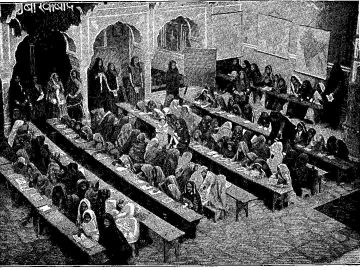
[Illustration: Hindoo Children at School.]
In some of the schools they have no desks or chairs, but the boys and girls sit on the floor. In other schools they have long tables instead of desks.
They do not learn their letters as we do. The teachers write five letters in sand on the floor. Then the boys and girls write the letters in the sand. They write the letters many times, until they know them well. Then the teachers write five more letters, and so on until the children know all the letters. When they can make the letters in the sand, they next learn to write them on palm leaves with pens made of wood. The last thing they do is to write them on slates and on paper.
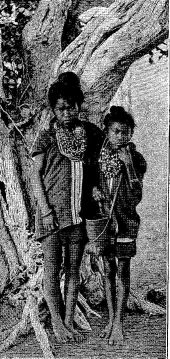
[Illustration: Native Children of India.]
In some of the large towns they learn to read and write English. But English is not the language that most of the people speak. They have a language of their own.
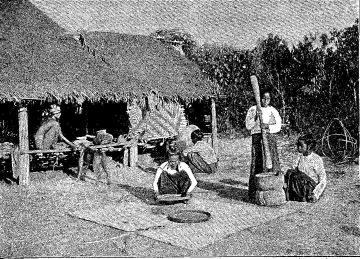
[Illustration: A Hindoo Family at Home.]
The people of India are called Hindoos. They have dark skin, dark eyes, and dark hair.
It is so warm that most of the people wear very little clothing. Many of the boys and girls wear no shoes. The girls are very fond of jewels. No matter how poor a family is, they try to buy some jewels for their girls. So the girls in India always have jewelry to wear.
They have no Christmas in India. They have what they call the "Feast of the Cakes." At the Feast of the Cakes they have three holidays. Then they have cakes of all kinds.
The boys are very fond of swinging. They are also very fond of swimming. In some places they have diving wells. The boys plunge from a high bank down into the water below.
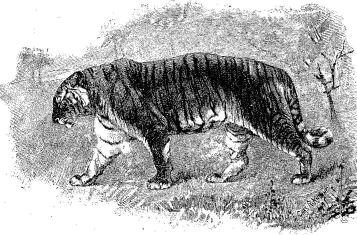
[Illustration: A Tiger.]
The rich people have very fine houses, with gardens and flowers and fountains. There are carpets, cushions, and tables in the houses, but no chairs. They sit on cushions on the floor.
The beds are very low, and the legs are often of silver or gold or ivory. They have no sheets or pillow cases, but covers of velvet or satin.
The people who are poor live in houses made of dried mud, with roofs of bamboo poles and straw. They have hardly any furniture. They sleep on mats made of palm leaves.
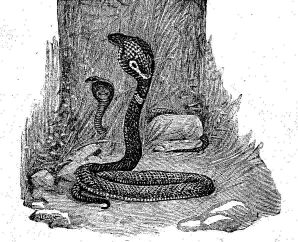
[Illustration: Cobras.]
In many of the houses they have no tables. They eat off of leaves on the floor. Their food is mostly rice. All the family do not eat together. The father of the family always eats first. When he has eaten, the mother and children sit down to eat.
The women do most of the work. So the girls have to learn to work. But the men and boys do all the sewing. How queer this seems!
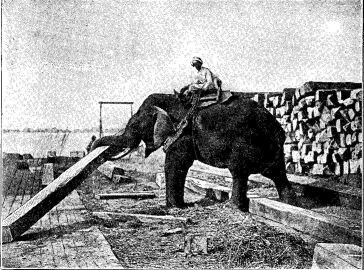
[Illustration: An Elephant Piling Lumber.]
There are a great many wild beasts in India--tigers, leopards, cobras, and crocodiles. The tigers are very fierce. They sometimes come into villages at night and carry off men, women or children, and kill and eat them. There are logs. They do work of many kinds. An elephant is much stronger than a horse. He can carry a far heavier load. Sometimes all the family ride on one elephant's back.
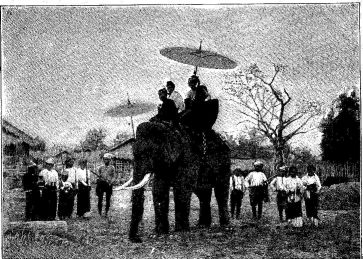
[Illustration: Riding on an Elephant.]
LAPLAND.
Jingle! jingle! jingle! Where does the merry sound come from? It comes from a sleigh drawn by a reindeer. The sleigh is called a "pulk'ha." It is made of birch wood. It has no runners. It goes on a little keel like that on the bottom of a boat. The sleigh is very low. It is pointed at the front like a rowboat, and is flat at the back. There are no seats in it. The driver sits in the bottom. The reindeer draws the sleigh, and goes very fast. If the driver is not very careful the sleigh may be upset.
It is in Lapland that you may see this kind of a sleigh. The people who live there are called Lapps. They are short and stout. You would think the men and women were boys and girls.
It is very cold in Lapland. The summer is short, and the winter is long. So the Lapps have to wear warm clothes most of the year.
The men and women and boys and girls in Lapland dress much alike. In the winter they wear a long outside coat called a _kap'ta_. It reaches below the knees. It is made of reindeer skin with the hair left on. Under the kapta they wear warm clothes made of wool.
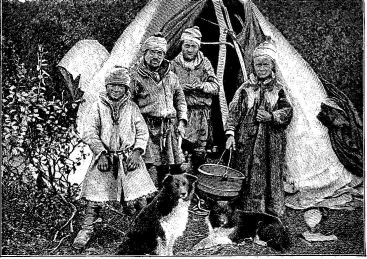
[Illustration: A Lapp's Tent.]
Their shoes are also made of reindeer skin. They wear two pairs of thick woolen stockings. When they put on the stockings, they wrap their feet in dry grass. Then they put on their shoes. The grass helps to keep their feet warm. They also wear two pairs of mittens at the same time. One pair is made of wool. The other pair is made of reindeer skin. Their hats or caps are also made of reindeer skin. They are lined with eider down. Perhaps you do not know what eider down is. It is the soft, fine feathers of a bird called the eider duck. A great many of these ducks are found in Lapland. Their down is very soft and warm.
Sometimes the Lapps have to go long distances in the snow. Then they put on skees. If you saw a pair of skees, you would think that a person could not walk with them. They are flat pieces of wood, four or five inches wide, and very long. Some skees are six feet long. Some are ten or twelve feet long. They are turned up a little in the front. In the middle of each there is a hollow place. The shoe is strapped to the foot there, as you see in the picture. When the Lapps go on skees, they do not raise their feet from the ground. They slide along, one foot after the other. They have a long pole, or staff, in their hands to beep themselves from falling. They can go very fast in this way. Sometimes they go ten or fifteen miles an hour.
[Illustration: Skees.]
In some parts of Lapland the people live in houses made of earth and stone. Each house has only one room. The Lapps have no carpets. They have no tables or chairs. They cover their floor with twigs of trees. They eat and sleep on skins spread on the twigs. They burn wood for fires. The fire is made on the ground in the middle of the floor. The smoke goes out through a hole in the roof.
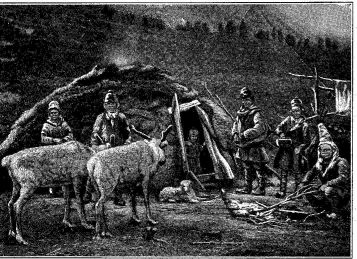
[Illustration: A Lapp Family at Home.]
The Lapps do not all live in the same way. Some of them are called mountain Lapps. In summer the mountain Lapps live in tents among the hills. Their tents are made of reindeer skin. They have a great many reindeer.
The reindeer is very useful to the Lapps. It gives them milk. It draws their sleighs. Its flesh is good to eat. They make clothes of its skin. They make knives and spoons of its horns.
In summer the reindeer eat the soft shoots of shrubs and trees. In winter they feed on moss called lichen. They get the lichen themselves. They would not eat it if it were gathered for them. In winter they dig down through the snow with their feet to get at the lichen. They dig first with one fore foot and then with the other. The snow is often so deep that the reindeer has to dig a hole so large that its body is almost hidden.
The reindeer are not put in stables. They like to be out in the cold and snow. They are able to take care of themselves.
The Lapps eat a good deal of meat. Their meat is the flesh of the reindeer. They are very fond of fat. All people who live in very cold countries eat a great deal of fat. It helps to keep them warm. The Lapps also have milk and cheese. They eat rye bread and fish and berries. They drink coffee.
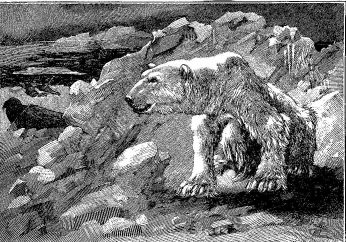
[Illustration: A White Bear.]
In winter they have to melt snow in a pot over the fire to get water. The rivers and lakes are all frozen.
The Lapps cook their food in a large pot over the fire. They sit around the fire to eat. The father takes a piece of meat out of the pot. Then he serves a piece to each. The Lapps use no forks. They use their fingers instead.
In some places they have a funny way of storing their food. They make a little log house on the top of a post. They have a ladder to go up to it. In this little house they store cheese and milk and other things. Then wild animals cannot reach them.
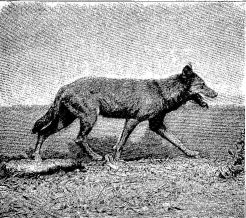
[Illustration: A Lapland Wolf.]
There are bears and wolves and foxes in Lapland. These animals are sometimes very fierce. They would come into the people's tents and houses at night, were it not for the dogs. Nearly every person has a dog. Even the hoys and girls have dogs. The dogs are very brave. They are not afraid to attack wolves or bears.
But you will wish to know about the children in Lapland. You have heard about the old woman who lived in a shoe. The Lapp baby has a cradle shaped like a shoe. It is made of a single piece of wood. It is lined with moss and other warm things. The mother often carries it in her arms. Sometimes she carries it on her back, slung from her shoulders. The baby plays with strings of buttons or glass beads.
When a baby is born in Lapland they give it a reindeer. If the reindeer has any young ones, they keep them for the baby until it is a man or woman. They also give a reindeer to the person who is the first to find that the baby has cut a tooth.
The Lapp boys and girls have very few toys. The toys they have they make themselves. The boys make willow flutes and play on them. When the boys go on the water they have long, narrow boats like canoes. Some boys also make sleighs.
Many of the boys and girls go to school. They learn to read and write and count.
There are towns near the sea and by the rivers and lakes. In these towns they have schools and churches.
GREENLAND.
Very strange people live in Greenland. They are called Eskimos. Greenland is a country very far north. It is always cold there. So the children need warm clothing. Their stockings are made of birdskin. The soft feathers keep their little feet very warm. Their shoes are made of sealskin.
An Eskimo girl does not wear skirts. Her clothes are like her brother's. Her trousers are made of white bearskin. Her jacket is made of fur. When she goes out sleigh riding, she puts on fur mittens. Do you know what a fur boa is? This little girl wears one around her neck. It is made of the tail of a fox. The strings to it are made of long pieces of skin.
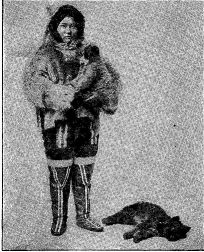
[Illustration: An Eskimo Girl.]
Perhaps you think the Eskimo children are white. No, they are brown. Their faces are round and fat.
Our babies ride in carriages, but an Eskimo baby rides on its mother's back. The mother wears a coat with a pocket on the back of it. The pocket is lined inside with soft reindeer skin. This makes a nice warm nest for baby.
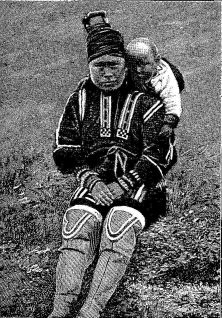
[Illustration: Eskimo Mother and Baby.]
In Greenland all the boys and girls have sleds. The runners of the sled are made of bone. The top is made of strips of sealskin. It has a back for the boy or girl to lean against. Dogs draw the sled across the snow. But the Eskimos also have sleds made of ice. I think you would like an ice sled. Oh, how fast it runs over the snow! The boys and girls have fine fun with these sleds!
They play a nice game in the snow with their sleds. I will tell you about it. Do you know what a reindeer is? It is like a deer, but it has long, branching horns. The horns are called antlers. When the Eskimos kill a reindeer for meat, the boys and girls get the antlers. They set these antlers up in the snow on a hillside. They leave spaces between the antlers. Then the boys and girls get on their sleds and slide down the hill. They must go between the antlers, but must not touch them. Sometimes the boys and girls have bows and arrows. They try to hit the antlers with their arrows. This is very hard, but it is great fun. Do you think you could do this?
The boys have boats made of long, thin bones covered with skins. These sail very well on the water. The boys use paddles to move the boats. A paddle is like an oar. The boys sometimes go in their boats to help their fathers catch fish.
Eskimo children cannot read or write. They do not go to school, for the Eskimos have no schools. They are very fond of stories, but they cannot read them in books. So their mothers tell them stories. The mothers cannot read, either. The stories they tell are what they heard from their mothers. Are you not happy that you can read stories for yourself?
Perhaps you think the Eskimo children are unhappy? Oh, no! Though they cannot read books, they play all kinds of games. There is a funny game they play in the house. All the children get on their knees in a ring. Then they hold their toes with their hands and move along by jumps. The one who goes the fastest wins.
The Eskimo boys play a game like the game of "cup and ball." They have two pieces of bone. One is flat, with holes in it. The other is long and sharp like a pin. Both are joined by a string about a foot long. The flat piece is tied to one end of the string, and the pin to the other end. The pin is held in the hand, and the flat piece is thrown into the air. The game is to catch the flat piece upon the point of the pin, by one of the holes.
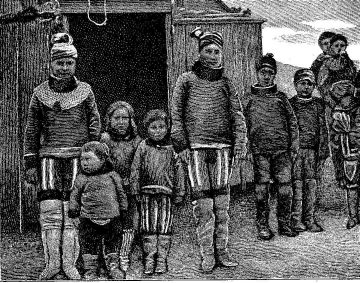
[Illustration: Eskimo Children.]
Eskimo boys play another game with a ball and a stick made of bone. It is something like shinny, one of the games yon play. They also play a game with a sealskin hall about as big as a baseball. They strike the ball with their hands and try to keep it in the air all the time. The Eskimo boys play football very well. They think it great fun. They never touch the ball with their hands; they only kick it.
The girls have dolls made of wood, with fur clothes. The dolls look like the little girls themselves.
Perhaps you would like to know about the houses the Eskimos live in. They have summer houses and winter houses. The summer house is a tent made of skins. The winter house is made of stones and earth covered with snow. It is not much higher than a man. They have a strange way of getting into these houses. A long, narrow passage leads from the door on the outside. They must crawl on their hands and knees along this passage. Then they go through a small opening into the house. The long passage keeps out the cold.
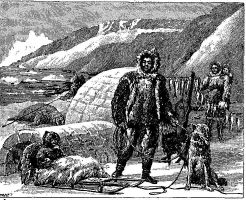
[Illustration: A Winter House.]
There is only one room in the house. Everything is done in this room. They sleep and eat and cook in it. The beds are of sealskins, and are made on a bench along the wall. There are no stoves in the house. The Eskimos use lamps to keep themselves warm and to give them light. They cook their food, too, with lamps. The lamps give great heat, and the houses are quite warm.
When the men kill a bear they have a party. At the party everybody sits around the lamp The bear is cut up and every one gets a piece. Then the children sing and dance. The Eskimos eat a great deal of meat. They kill seals and bears and birds for their meat. They also eat berries and seaweed.
There are no tables in Eskimo houses. A large dish is set on the floor. The family sit round it and eat out of it. They cut their meat with knives made of bone. Their cups are made of sealskin.
Do you know what a seal is? It is an animal with thick fur. Sometimes it lives on the land and sometimes in the water. The people in the North kill it and make clothes of its skin. Its fur is very warm and makes fine jackets. The Eskimos eat the flesh of the seal. They make knives and other things of its bones.
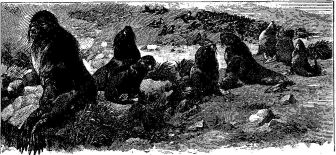
[Illustration: Seals.]
Eskimo boys and girls have a funny kind of candy. It is the red skin of a bird's foot soaked in fat. You would not care for this. But the Eskimo children eat it and like it. The cold weather makes them like to eat fat.
RUSSIA.
"Your nose! your nose, sir!" This is a cry often heard in the streets of Russia.
Russia is a very large country. Part of it is in Europe. A great part of it is very cold. When a person in the cold part of Russia goes out riding in winter, he has to cover his face, all except the nose and eyes. Sometimes his nose gets very cold, and would freeze if some one did not cry out, "Your nose, sir!" Why? When one's nose gets so cold, it becomes numb. It has no feeling. One would not know that it was freezing if some person did not cry out. The cold nose must then be rubbed with snow. You would think this a strange way to keep it from freezing, but it is the best way to take out the frost.
There are many kinds of houses in Russia. The houses have to be made very warm. So they are built with double walls. In rich people's houses they have stoves like ours. But in the poor people's houses the stoves are built of brick. They always burn wood, for coal costs too much in Russia. The stoves are sometimes built very high. Often they are as high as the ceiling. Sometimes people lie on top of the great stove to keep themselves warm.
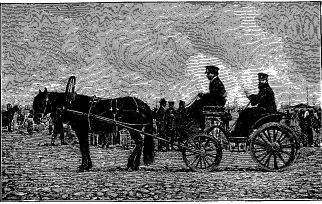
[Illustration: A Russian Carriage.]
In most of the houses in the country, they have no beds. There are benches along the wall, which they use both for chairs and beds. In some houses the children sleep on the floor on pieces of felt.
Most of the people in Russia are farmers. They raise a great deal of wheat. The people in many other countries get wheat from Russia.
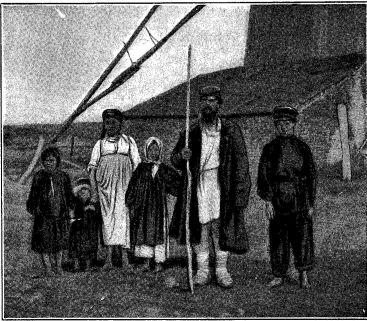
[Illustration: A Russian Farmer and his Family.]
The children have to wear very warm clothes because it is so cold the greater part of the year. Their coats are lined with fur. In winter the children in the towns have great fun on the ice hills. Ice hills are made in all the towns.
First they build a high tower, and down from the top of it they make a steep hill. Blocks of ice are laid on this hill and water is poured over them. The water freezes, and thus the ice hill is made. On one side of the ice hill there is a place to draw up the sleds. The boys and girls start at the top, and down they go with merry laughing and shouting! So you see they have fine sport on their ice hills.
When the children are not playing on the ice hills, they go skating or sleighing.
In some parts of Russia they have funny ferryboats. When the rivers are frozen over in winter, the boats cannot sail on them. Then the people use chairs instead of boats. There are warm covers on the chairs, and men on skates push them across the ice. It costs less than one cent to ride across a river in one of these chairs.
In St. Petersburg they build an ice palace every winter. St. Petersburg is the largest city in Russia. It is the place where the emperor lives. The Emperor of Russia is sometimes called the Czar.
They make the ice palace with square blocks of ice. They put the blocks together and pour water between them. When the water freezes, the wall is solid like a wall of brick or stone. Everything inside the palace is made of ice. There are ice stairs and ice tables, and ice chairs, and beautiful flowers made of ice. Warm rugs of fur are put on the chairs so that people who sit on them may not be cold. Often there are grand balls and parties in this beautiful palace of ice.
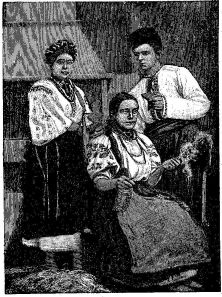
[Illustration: A Russian Family.]
In summer, too, the boys and girls in Russia have a good time. The boys have wrestling matches, for they are strong.
The girls have a game like ring-around-a-rosy. They also have a game much like our seesaw. A girl stands on each end of a board. Then one girl jumps up and comes down on the board. This sends the other girl up, and in her turn she comes down on the board and sends the first girl up. And so they play on, going up and down. This is not an easy game to play. It is some time before the girls can do it well. Some girls are so skillful at this game that they can keep jumping a long time without falling.
Some people in Russia have very queer cradles for their babies. One kind of cradle is a basket which hangs by ropes from the ceiling. Another kind of cradle is made of cloth sewed to a wooden frame. This cradle also hangs from the ceiling. In some places in Russia the nurses who take care of the babies wear dresses to show whether the baby is a girl or a boy. If it is a boy the nurse wears a blue dress. If it is a girl the nurse wears a pink dress.
There are not schools in all parts of Russia, but in some places there are good schools, and the children learn to read and write.
I must not forget to tell you of the great bell in Russia. It is the largest bell in the world. It is in Moscow, a very old city of Russia, and it is called the great bell of Moscow. But it has never been rung, for it was cracked in the side when it was being made. It is nearly twenty feet high, and is now used as a chapel.
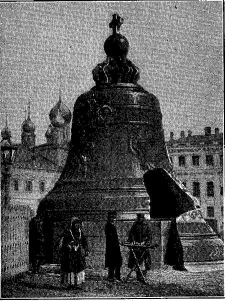
[Illustration: The Great Bell at Moscow.]
The next largest bell in the world is also in Moscow. This bell is hung up in a church; and when they ring it, the sound is heard all over the city like the rolling of thunder.
SWITZERLAND.
Switzerland is a land of mountains and hills and valleys and beautiful lakes and streams. Every year many people go from all parts of the world to see the beautiful Swiss mountains and valleys.
Sometimes large masses of snow and ice, mixed with earth, fall or slide down the sides of the mountains with a loud crash. As they slide, they tear away rocks and trees, and bury houses and villages beneath them. These masses of snow and ice are called avalanches.
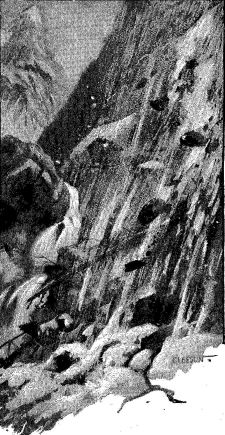
[Illustration: An Avalanche.]
Snow falls all the year round on the tops of the mountains in Switzerland. As the snow falls, it packs down hard and changes into ice. At last it becomes a great mass of ice, and slides very slowly down the sides of the mountains into the valleys. These masses of ice are called glaciers. They move so slowly that you cannot tell they are moving by looking at them. But by driving a stake down, you can see, after a long time, that the ice has moved a little way.
A great many of the people in Switzerland live by keeping cattle and sheep and goats. Their houses are in the valleys. But in spring, when the snow begins to melt and the grass begins to grow, the men drive their flocks up the mountain sides to feed. There they stay till the end of summer. The men take with them a supply of food, and they sleep in huts on the mountain side.
There is a kind of goat in Switzerland called the chamois. It lives high up in the mountains. It is very hard to hunt the chamois, for it can go into places where a man cannot follow it. It can leap very nimbly from one rock to another. It can go up and down a rough mountain side.
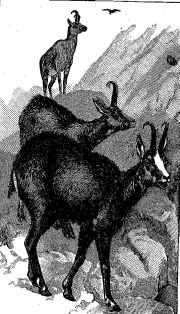
[Illustration: Chamois.]
In the summer the chamois feeds on herbs and flowers. In winter it eats the shoots and buds of pine trees. It is very fond of salt. There is a kind of stone in the mountains that is partly made of salt. The chamois licks these stones to get the salt.
The chamois feed together in herds of fifteen or twenty. One of them is always on the watch to give notice if anybody comes to hunt them. When it sees any one coming, it stamps on the ground with its fore feet and makes a sharp cry. Then all start off. They leap from crag to crag till they are far out of danger.
The skin of the chamois is very soft. It is made into a fine, soft leather. This leather is called shammy leather. Have you ever seen a piece of shammy leather? The flesh of the chamois is very good to eat.
The people in Switzerland use a great deal of milk and butter and cheese for their food. They also have potatoes and bread and fruit. They eat very little meat.
The Swiss houses are made of wood. Stones are often put on the roofs. The stones keep the shingles from being torn off by the wind. The Swiss are very neat and clean. On every window sill there are flowerpots, for the Swiss are very fond of flowers.
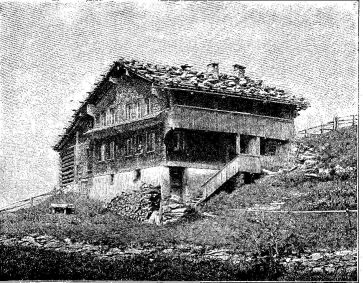
[Illustration: A Swiss House.]
In every village in Switzerland there is a school. The Swiss have very good schools. The boys and girls must go to school when they are six years old. They learn all that we learn in our schools. There are also schools where the boys are taught trades. The boys and girls go to school only eight months in the year. So they have four months' vacation.
After school, the boys help to take care of the sheep and goats and cattle. The girls help about the housework. All find plenty to do.
But the Swiss boys and girls have some time for play as well as for work and school. They often have holidays. One of their greatest holidays is the day that the men come home from the mountains with their flocks. The boys and girls go out to meet them. They sing songs. The bells ring, and flags wave. Everybody is merry and happy.
The children in Switzerland have a great many pretty toys. Some of their toys are made to play music. The Swiss make all kinds of music boxes.
In Switzerland, instead of a king, they have a president, as we have. And in past times they had brave men who fought to make their country free. One of their great men was William Tell. The Swiss love his name as strongly as we love the name of George Washington.
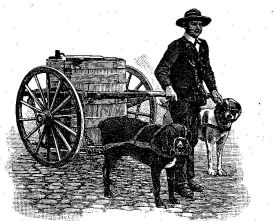
[Illustration: Swiss Dog Cart.]
HOLLAND.
The people who live in Holland are called Dutch.
There are many canals in Holland. In some of the towns they have canals instead of streets. There are bridges across the canals for people to go from one side of the street to the other. In some of the streets they have no sidewalks, and nothing between the houses but canals.
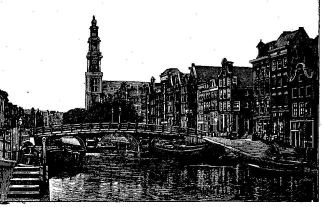
[Illustration: Canals in Holland.]
In most of the houses they have no carpets. They scatter white sand on the floor every morning. They keep their houses very clean. In their kitchens they have open fireplaces, with fires blazing brightly. Near the fires they have footstools made of cork. In some houses they have fire boxes for warming their feet. They can carry these boxes wherever they like. In cold weather they take their fire boxes to church.
Wherever you go in Holland you see windmills. When you see them far off they look like giants with their arms stretched out. The arms are shaped like ladders. The arms have sails on them to catch the wind. It is the wind that makes the arms go round. With these windmills the people pump up water, and grind corn, and saw wood. The land is very flat and low. There are no swift running streams to turn the mills. So the people build windmills.
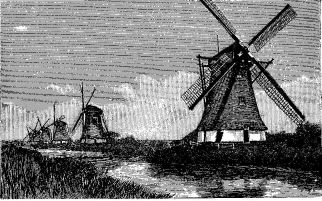
[Illustration: Windmills in Holland.]
The great wonder of Holland is the dikes. Holland is near the sea, and so dikes are built along the beach to keep the water out. The dikes are strong walls made of earth and stones. They are very high, and so thick that on the top there is a road to walk and ride on. In some parts of Holland there are houses also on the top of the dikes. If it were not for these dikes, the sea would flow in on the land. Then it would cover the houses and towns, and drown the people.
Did you ever hear the story of the little boy and the hole in the dike? The little boy's name was Hans. He lived near the great dikes along the sea. One day his mother sent him on an errand.
When he was coming home, he saw water flowing from a small hole in the dike. He knew that the water came from the sea. Then he said to himself, "If that water is not stopped, the hole will get larger. Then the sea will break in, and we shall all be drowned."
So Hans went up to the dike and put his hand against the hole, and stopped the water. This was very hard to do. But the little fellow held bravely on.
When night came and Hans did not come home, his father and some of the people who lived close by went to search for him. After many hours they found him at the dike, keeping the water back with his hand. Then his father took him home, and the men stopped up the hole in the dike. Everybody praised Hans for what he had done.
The little children in Holland are very pretty. They have round, fat faces, golden hair, and blue eyes. The boys wear wide trousers and little round caps. The girls wear jackets and skirts and little caps with gold braid.
Both boys and girls wear wooden shoes. And what a noise they do make with their wooden shoes when they run around! They have great fun playing their shoes are boats. They sit on the sides of the canals and take off their shoes and sail them on the water like little boats. They tie strings to the shoes so that they can draw them in whenever they like.
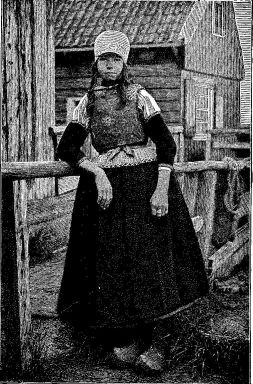
[Illustration: Dutch Girl with Wooden Shoes.]
Dutch children do not wear shoes in the house, but wear slippers. When they go home after playing or from school they take off their shoes. They leave them outside the door. Would you not think it strange to see rows of little shoes outside the doors?
Every Saturday the children clean their shoes. But they do not shine them as we do. They wash them with soap and water, and dry them at the fire. If the sun shines, they hang them on a bush to dry. When they are dry, they are almost as white as snow.
Winter is a very merry season in Holland. Then all the canals are frozen, and there is great fun skating. Everybody has skates, even the little children. And how merry and happy the boys and girls are, skimming along on the ice!
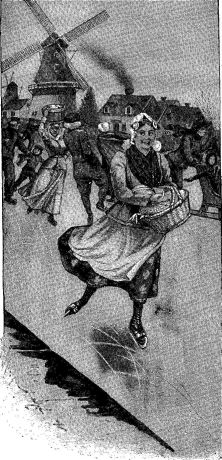
[Illustration: Skating in Holland.]
The men and women go to market on skates. Those who do not wish to go on skates go in sleds or chairs with runners on them. The chairs are pushed by skaters.
But the best fun of all is on the ice boats. The ice boats have sails, and can go very fast on the smooth ice.
The first day of skating every year is a holiday. There is no school that day, and everybody goes out skating, or riding in sleds or ice boats. How glad the boys and girls are when Skating Day comes! What fun they have! And of course they have sleigh riding, for every family has a sleigh. The sleighs are made like shells, or boats, or swans. When the people go sleigh riding at night, they carry lighted torches.
The greatest holiday the Dutch have is Santa Claus's day. It is on December 6. All the stores are made pretty on that day. Santa Claus is in the windows. He is dressed in red with white fur, and rides a large horse. The streets are crowded with boys and girls to see all this. They have Santa Claus cakes, and gingerbread made like chairs and tables and fishes and horses and many other things.
At night Santa Claus rides on the roofs of the houses, and drops nice things down the chimneys for good children. And the boys and girls leave their shoes near the fireplace for the things to drop in. But they do not find many toys in their shoes, for Santa likes better to give them cakes and money. The Dutch boys and girls have not many toys, but they play for hours with their shoes. They use them for boats, baskets, dishes, or beds for their dolls.
They have fine schools in Holland, and the boys and girls go to school and learn the same things that we learn in our schools.
Some Dutch girls go to market to sell milk or cheese. They have donkeys to carry the milk or cheese. Sometimes, the girls ride on the donkeys' backs.
Some Dutch girls also go to market to sell fruit. They carry the fruit on a pole across the back of their shoulders. A basket of fruit hangs from each end of the pole, as you see in the picture. The boys sell milk. They carry it about in little wagons drawn by dogs. They are very kind to the dogs. They do not make them draw too heavy a load.
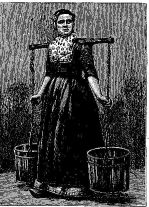
[Illustration: A Dutch Milkmaid.]
When a baby is born in Holland, some one hangs a silk ball outside the door. If the baby is a boy, they hang up a red ball; and if it is a girl, they hang up a pink ball. Is not this a good way to let their friends know they have a new baby?
PATAGONIA.
Have you ever seen a man with pictures on his body? Perhaps you have seen a sailor with a picture of a ship on his arm. In Patagonia nearly all the men and boys have pictures on their bodies. Patagonia is in the southern part of the world. It is winter in that country when it is summer here, and summer there when it is winter here.
Patagonia is a very flat country. There are very few hills and no large trees or fine flowers there. But there is plenty of good grass, which sometimes grows very tall.
The people in Patagonia are Indians. They have red-brown skin, long black hair, and small eyes. The men are very tall. Some of them are seven feet high. They paint their faces red and black, and tattoo their arms. They do this with a needle. They put the needle into dye, and then prick the skin with it.
The men wear a piece of cloth around their waists and a large cloak of fur. They sometimes wear boots made of the skin of horses' legs. The women wear gowns fastened at the neck with a pin. They also have cloaks like the men.
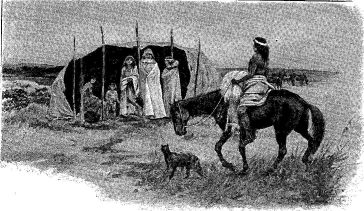
[Illustration: Patagonians at Home.]
The boys and girls wear no clothes until they are four years old. After they are four years old they wear the same kind of clothes their fathers and mothers wear. The young girls wear their hair in braids. If their hair is not long enough, they make it longer by tying horsehair to it.
The houses in Patagonia are tents made of skins. There are rooms in the tents, and each grown-up person has a room. The fire is made inside the tent on the floor.
The people in Patagonia eat gua-na-co and ostrich meat. Some of the people drink a kind of tea made from the leaves of a plant. The leaves are first crushed fine, then put into water. They drink this tea through a small tube with many holes in it. The holes are so small that the pieces of leaves cannot come through. This tea is very good to drink. It makes the people very strong.
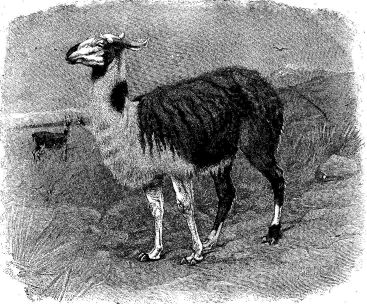
[Illustration: Guanaco.]
The women do all the work about the house. They make the clothes, carry home the wood for the fire, and bring water from the streams or wells.
The men do nothing but hunt. They hunt the guanaco and the ostrich. The guanaco is nearly as large as a cow, and has a head like a camel. Its flesh is good to eat, and the people make cloaks of its skin.
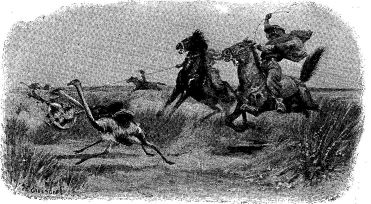
[Illustration: Hunting Ostriches.]
The ostrich is the largest bird in the world. Its legs are very long, and it has a long neck. It cannot fly, for its wings are too small, but it can run very fast. It can run faster than a horse. It is hard for the hunter to catch it. He rides on horseback, and catches the ostrich with a bo'las. A bolas is a rope with a stone, a metal ball, or a lump of hard clay fastened to each end. The hunter swings one end of the bolas round and round his head, and then hurls it with great force at the ostrich. It strikes the ostrich or catches it by the legs and throws it down. Then the hunter runs up and kills the ostrich with a knife. The hunters also hunt the ostrich with dogs. Sometimes an ostrich will spring suddenly up from the long grass almost in front of the hunter and his dogs. Then the dogs can easily catch it.
The ostrich makes a hole in the ground under a bush for its eggs. This is its nest. The eggs are very large, and they are good to eat. Its flesh is also good to eat. Of course you know ostrich feathers are pretty for ladies' hats. The feathers for hats are taken from the tail and from the ends of the wings. But the feathers of the ostrich in Patagonia are not so fine and pretty as the feathers of the ostrich found in Africa.
There is an animal in Patagonia called the puma. It is like a cat, but it is much stronger. Often it kills and eats the guanaco.
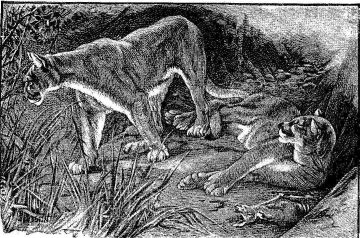
[Illustration: Pumas.]
The boys and girls in Patagonia have very few toys, but they are merry and happy. As the boys grow up, they soon learn to hunt; and then they go out with their fathers to hunt the guanaco and the ostrich.
THE PYGMIES.
Perhaps you have read in fairy tales of very little people called dwarfs. There are old stories which tell us about very small men who lived a long time ago in Africa. They were called pygmies. They were only one foot high, and they built their houses with eggshells. They lived in holes in the ground. They had goats and sheep which were much smaller than themselves, and they had corn which they cut down with axes, as we cut down trees.
This is what we are told about them; but, of course, those stories are fables. There never were men so small as one foot high.
But there are real people in Africa called pygmies. They are very small. The men and women look as if they were boys and girls. The men are about four feet high.
There are a great many large forests in Africa. It is in the forests that the pygmies live. The forests are so dark in many places that one could not see to read at noonday. Only a few white men have been in the land of the pygmies and seen them. They are shy, like children, and hide their faces when spoken to.
Some of the pygmies are black and some are red. They do not wear much clothing. They do not need much, for the weather is always very warm in the country in which they live. The men and boys wear only a strip of cloth around their loins.
Many of the pygmies have no houses. They wander from place to place, and sleep on the ground under a bush. But some of them have little houses, or huts, built in the shape of beehives and about four feet high. They are covered over with long leaves. The door is only about a foot and a half high, just high enough for the pygmies to creep in. Their beds are made of sticks stuck in the ground with other sticks across them.
The pygmies live by hunting. They do not shoot with guns, as we do. They use bows and arrows, and they are very quick and clever at shooting. A pygmy will shoot off three or four arrows one after the other so quickly that the last is flying away before the first has hit the mark.
The pygmies are also very smart in making pits to catch the animals they wish to kill. They dig large holes and cover them with sticks and leaves. The animal comes along and falls into the pit and is caught. The pygmies can kill elephants with their bows and arrows. They first shoot at the elephant's eyes until he is blind. They then keep shooting at him till he falls dead.
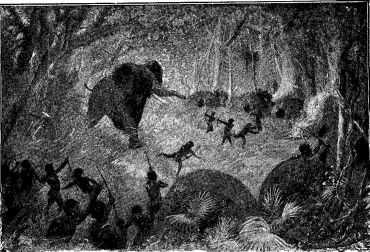
[Illustration: A Village of Pygmies.]
The pygmies eat the flesh of some of the animals they kill. They sell or trade the fur and skin and ivory for arrows and knives. They also get tobacco and potatoes for their furs and skins.
They are also very good at fishing. They can catch large fish with a piece of meat fastened to a string.
The pygmies do not dig the ground or plant or sow anything. Bananas grow in Africa, and the pygmies are very fond of them. Often they come out of the forests to get bananas from the trees on which they grow. If a pygmy sees a good bunch of bananas that he would like to have, he shoots his arrow into the stalk. When the owner of the tree sees the arrow he knows how it came there. So he leaves the stalk until the pygmy takes it away. Sometimes a pygmy pays for the bunch of bananas with pieces of meat. He wraps up a piece of meat in grass or leaves, and fastens it to the stalk where he has cut off the bananas.
A pygmy can eat twice as many bananas as the largest white man. He can eat as many as sixty at one meal.
Though the pygmies are small, they are very brave, and all the other people who live near them are very much afraid of them.
THE INDIANS.
Long, long ago, before Columbus found America, the Indians lived where we live now, There were no cities or houses then, such as we have. There were no farms or gardens or fences or roads. A large part of the country was covered with trees. The rest was great grass plains and swamps.
The Indians built their houses where they pleased, beside the rivers or near the mountains or on the wide plains. What sort of houses did they live in? They lived in tents made of skins. The Indian tents were called wigwams.
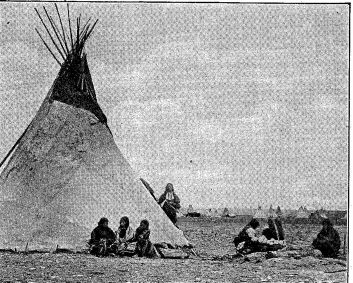
[Illustration: An Indian Wigwam.]
There were many tribes of Indians. Each tribe had a great many men and women and children. Some of the tribes lived in the north, some in the south, some near the sea. In nearly every part of the country there were Indian tribes. Often some of the tribes went to war with other tribes. They fought with bows and arrows and tomahawks. The tomahawk was a sort of hatchet. The head of it was made of a stone with a sharp edge.

[Illustration: Indian Bow and Arrows.]

[Illustration: Tomahawks.]
The Indians were very cruel in war. When they killed a man, they cut the skin and hair off the top of his head. This was called scalping.
When about to go to war, they painted their faces to make themselves look very fierce. They also wore a band around their heads, and in these they stuck some long feathers.
There are Indians still in some parts of our country, and many of them live in wigwams. They sleep in these wigwams, but they cook their food outside. They have no coal or stoves or fire-places. Instead of coal they use wood and dried grass. They make their fire on the ground. Their food is very simple. They have meat and fish and berries, and cakes made of corn. The meat they eat is the flesh of the deer and other wild animals.
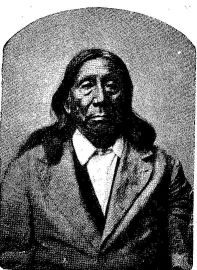
[Illustration: An Indian Chief.]
The Indians are of a copper color. They are sometimes called "Red Men." They have high cheek bones, black eyes, and straight black hair.
The Indian men spend their time hunting and fishing. They do not have bows and arrows now. They shoot with guns as white men do.
The Indian women do all the work. They cook the food, make the clothes, and plant the corn. They also put up the wigwams and take them down. For the Indians do not live always in the same place, but often move about.
An Indian woman is called a squaw, and an Indian baby is called a pa-poose'. You would wonder if you saw the Indian baby's cradle. It is a bag made of skin fixed to a flat board. It is just large enough for baby to fit in. The little papoose is wrapped up warm and put into the bag. The mother carries the baby on her back in this cradle. Often she hangs the cradle up on a branch of a tree. Then the little red baby swings while its mother is cooking or working in the field.
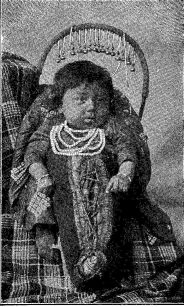
[Illustration: An Indian Baby.]
The men, women, and children wear clothes made of skin. They often wear blankets as shawls are worn by white people. Their shoes are made of deerskin and have no soles. They are called moccasins.

[Illustration: Moccasins.]
In many places the Indians now have schools, and the little Indian boys and girls go to school every day. Our government has sent teachers to teach them. They learn to read and write and count.
But the Indian boys and girls learn a great many things at home. Their fathers tell them about birds and beasts and trees and rivers. And they teach the boys to hunt and fish, and train them up to be brave in war.
The Indian boys and girls have a great many games. The boys play with bows and arrows. They play "blindman's buff," and "hunt the slipper," and handball and football. The girls take part in the football. One of their games is the "stick and ring" game. The ring is made of skin and is sometimes covered with beads. Each boy has a stick, and he throws it at the ring while it is rolling along the ground. The game is to send the stick through the ring. Every boy tries to strike every other boy's stick to stop it from going through the ring.
The Indian boys sometimes play at fighting battles. They form themselves into two armies, and one army fights against the other. They fight with balls of wet clay. Often the battle lasts two or three hours.
Indian girls have dolls, and they dress them and sing them to sleep. They play "house," and often have doll-house moving.
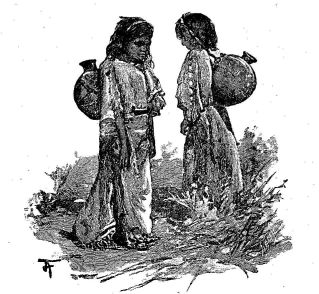
[Illustration: Indian Girls.]
Indian men and boys are fond of swimming, and they are very good swimmers. They are also fond of sailing in their canoes. The canoe is made of the bark of the birch tree. The Indians paddle their canoes. They can make them go very fast.
Many of the Indians now live in houses and have farms the same as white men, and they raise corn and vegetables and fruit. They have horses and cows and sheep as other farmers have. And we may hope that before long the Red Men will live in the same way as white men, and be as well off and as happy.
THE PHILIPPINE ISLANDS.
The Philippine Islands are far away on the other side of the earth, near China. There are a great many of these islands. Most of them are small. But some of them are large islands, and many people live on them. The largest of the islands is called Luzon. The largest town in this island is Manila.
Many tribes of people live in the Philippine Islands. Each tribe has a language of its own.
It is very warm in these islands. So the people need but little clothing. Their houses are not very high. The highest house is only two stories. In some parts they have strange windows in their houses. The panes are not made of glass, as in our houses. They are made of oyster shells. But they are not like our oyster shells. They are very thin--so thin that the light can come through them nearly as well as through glass. The shell is made square, and fits in the window like a pane of glass. Sometimes the sides or walls of the upper stories are made of frames, with oyster shells for panes. The people can slide these walls back, so as to let the cool air into the rooms.
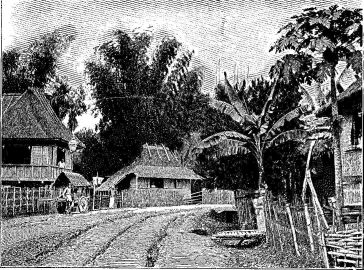
[Illustration: A Philippine House.]
There is one tribe in the islands called the Moro tribe. The people of this tribe have very strange houses. They build their houses in the water near the shore. They build them on the top of long poles. The first stories are high above the water. The people use ladders to go up to them. These houses are built of bamboo.
The bamboo is very useful in the country where it grows. It is a kind of reed, and grows very tall. It has joints like the joints of a corn stalk. It is not solid like a corn stalk, but is hollow inside. It is so thick and strong that the people make houses of it and all kinds of furniture.
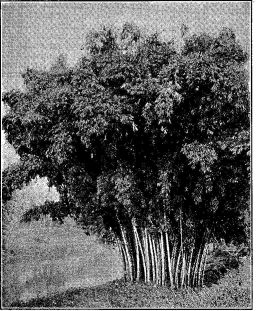
[Illustration: Bamboo.]
The Moro men are good sailors and swimmers. They are also good divers. They dive into the water for pearls and coral. They can stay under the water for two or three minutes at a time. The children also are good swimmers. They spend a great deal of time in the water.
There is another tribe called the Man'gy-ans. These people live in the mountains. They have black hair and flat noses. They are very strong, for they spend most of their time out of doors.
Some months of the year they do not live in houses. They sleep under trees. But other months of the year it rains very much. Then they sleep in houses. Their houses are made of poles with roofs of leaves.
The Mangyan women and girls wear a very strange kind of dress. It is made of cords coiled around their waists. The cords are narrow strips of rattan braided together. Rattan is the stem of a plant which grows to a very great height. It sometimes grows a hundred feet high. It is as thick as a man's wrist, and it is very tough and strong. The people split the rattan into thin strips. With these they make baskets, seats of chairs, walking canes, ropes, and many other things.
The Mangyan men are good hunters. They hunt an animal called the tim'a-rau. It is like a buffalo. They shoot it with bows and arrows.
There are a great many large forests in the Philippines, and there are very fine trees in them. The most useful of the plants or trees is the bamboo. I have already told you about it. The cocoanut palm is also a very useful tree. The nuts give food and drink and oil.
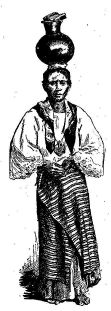
[Illustration: A Philippine woman carrying water.]
On one of the islands there is a wonderful plant called the pitcher plant. Its leaves are in the shape of pitchers. Some of the pitchers have lids, and are large enough to hold a pint of water.
In the Philippines they raise coffee, bananas, sugar, tobacco, and cotton. One of their most useful plants is the plant from which they get hemp for making ropes and cords. This plant is called "ab'a-ca" by the people in the Philippines, and its hemp is called Manila hemp.
There is a great deal of rice grown in the Philippines. Rice is the food that most of the people live on.
There are buffaloes in the Philippines. The people use them for riding and for carrying loads. They have also deer, goats, and hogs.
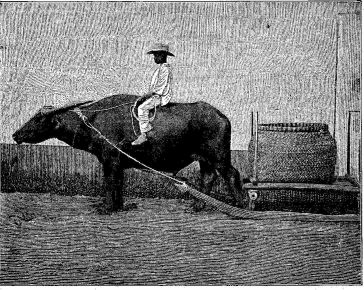
[Illustration: A Buffalo at Work.]
In some parts of the islands they have a strange way of fishing. They fill baskets with a kind of mixture in which they put poison. Then they throw the baskets into the water. The fish become stupid after eating the poison. Very soon they rise to the top of the water, where the people catch them.
Manila is a large town with strong walls and a deep moat, or ditch, around it. There are eight gates in the wall and bridges across the moat.
The men in Manila wear trousers and shirts; but they wear the shirts outside. The women wear skirts with long trains, and waists with very full and flowing sleeves. They wear scarfs or handkerchiefs around their necks, with two of the corners hanging down their backs. They never wear hats.
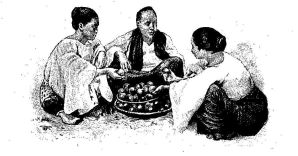
[Illustration: Women of Luzon.]
In a few of the islands there are schools, and the children learn to read and write; but in many other parts there are neither schools nor churches. As the islands now belong to the United States, there will soon be many more schools, and the children will be able to learn everything that is taught in our schools.
BANGALA
Far away in Africa, near where the pygmies live, there is a great river called the Kongo. The land on either side of this river for many miles is called the Kongo Valley.
There are hundreds of miles of great woods in this valley. These woods are not like our woods. They are very thick with vines and plants. There are also a great many kinds of trees.
In the woods are birds with very bright colors. There are birds called sunbirds. Often green, yellow, scarlet, and purple feathers are found on these birds. What a pretty sight it must be to see them flit about in the sun!
There are also many kinds of pretty flowers in the woods. These flowers are as gay in color as the birds.
Many tribes of negroes live in the Kongo Valley. They live in huts made of mats. The mats are made of strong grass. The grass is first twisted into cords. Then the cords are braided into mats.
The people also use mats for their beds; but they do not put the mats on the ground. They tie them to a frame raised a little above the ground.
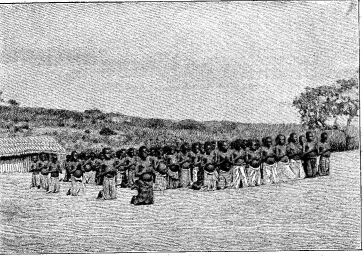
[Illustration: Kongo Negroes at a Mission School.]
These negroes also make baskets, bowls, pots, and wooden spoons. The bowls and pots they make out of clay.
It is very warm all the year round in the Kongo Valley. So the people wear very little clothing. They rub their bodies with palm oil.
They have a funny way of wearing their hair. While they are young their hair is braided. Then it is twisted into all sorts of knots and shapes. They do not untwist it, but keep it so always. They think these queer knots and shapes are very pretty.
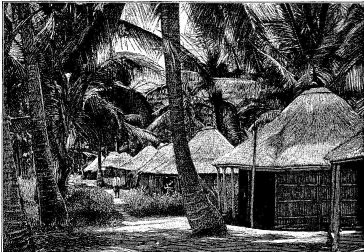
[Illustration: A Kongo Village.]
The women do all the hard work. They cook the food. They do the other housework. They plant the corn and beans.
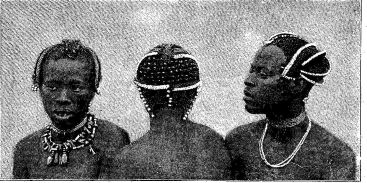
[Illustration: Headdress of Kongo Women.]
The men spend a great deal of time in fishing. They also hunt and kill elephants to get their tusks for ivory. There are many elephants in the Kongo Valley. They roam about in large herds. It must be a hard task to kill an elephant!
One of the tribes in the Kongo Valley is called the Bangala tribe. The men are tall and strong and fierce. They are always fighting with other tribes. This makes the other tribes very much afraid of them.
The negroes of this tribe have a strange way of making friends with a white man. They will do him no harm if he is willing to be their "blood brother."
This is the way they make a white man their blood brother. The black man takes a limb of palm tree which has two branches. With one branch in his hand, he falls on the ground before the white man. The white man takes hold of the other branch. Then the black man splits the limb into two parts with his knife.
After this is done, an old man of the tribe comes to the white man and the black man. He puts the white man's arm over the black man's arm. When their arms are together, he makes a small cut in each arm. He makes this cut to draw blood. Then the old man puts salt and the dust of banana leaves into the blood, and rubs both arms together. The black man and the white man are then blood brothers.
These people have also a strange way of taking care of their canoes. When they are not using them, they keep them under water. They say that the canoes will last longer if kept under water.
THE AMAZON VALLEY.
Perhaps you have heard of the Amazon River. It is the largest river in the world. It is four thousand miles long, and more than fifty miles wide where it flows into the sea. This river is in Brazil. Brazil is far south of us.
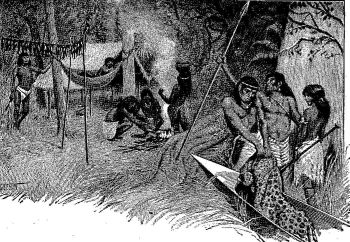
[Illustration: Amazon Indians.]
There are great forests along the banks of this river. They run back from the river for hundreds of miles. They are the largest forests in the world.
A great many kinds of trees grow in these forests. Some of the trees are very high. Often the trees are covered with vines on which beautiful flowers grow.
Wax-palm trees, breadfruit trees, and rubber trees are found in these forests. Wax is taken from the leaves of the wax palm.
We make rubber from the rubber tree. A cut is made in the side of the tree with a knife. From this cut a white juice flows. This juice is like milk. It is caught in a cup. After a while the juice gets hard. Then it is rubber.
A great many strange animals and birds are found in these forests. There is the sloth, which lives in the trees. It has hooked claws for holding on to the branches. It hangs on to a branch with its back downward. When it goes to sleep, it rolls itself up like a ball. It moves very slowly, and that is why it is called the sloth.
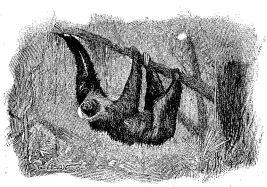
[Illustration: A Sloth.]
These forests are full of monkeys and parrots. Perhaps you have seen a parrot. I dare say you have not seen more than two or three parrots at one time. But in these forests there are flocks of parrots. They fly from tree to tree, and are very wild.
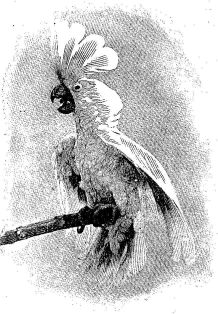
[Illustration: A Parrot.]
There are many kinds of them. Some are red, some are green, some are blue, and some are all these colors.
Monkeys chatter and parrots screech. What a noise they must sometimes make!
But besides the parrots and the monkeys, there are humming birds and butterflies. You know that the humming bird is a very small bird, but humming birds are found in these forests no larger than a bee. The butterflies are the most beautiful in the world.
The people who live in these forests are called Indians. They do not often let white men come among them. Their skin is copper color, like the Indians of our country. Their hair is black and straight. They are not as tall as our Indians, but their bodies are finely formed. They have large, full chests. Their hands and feet are small and nicely shaped.
They keep themselves very clean. The men and women, the boys and girls, are all fond of bathing. The first thing they do in the morning is to take a bath in the nearest river.
Strange to say, some of them paint their faces and bodies. They take the juice of a tree which will stain a blue black. They pour this juice on their heads, and let it run in streams down their backs. They also put red and yellow in large round spots on their cheeks and foreheads.
The men braid their hair, and wear it long, down their backs. They part their hair and wear combs. But the women do not part their hair and do not wear combs. They pull the hair out of their eyebrows. They make holes in their ears. In these holes they wear, instead of rings, a little piece of grass with feathers fastened to it.
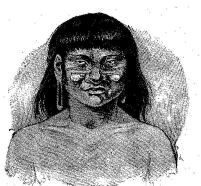
[Illustration: A Painted Amazon Indian.]
Their houses are made of logs of wood set in the ground as posts. They put other logs on top of these for a roof. Then they cover these logs with palm leaves. There are no windows, and they use mats for doors.
They sleep in hammocks. These they make of string. They make the string by twisting the leaves of a tree.
They have plenty of pans and pots, both large and small. These pans and pots they make of clay.
First, they soften the clay and knead it. Then they shape it into pots and pans. It is then dried in the sun. When the pots and pans are dry they are put in a hot fire. This makes them hard and strong.
The chief food of these Indians is a kind of flour made from the root of a plant. They also eat fish. A great many fish are found in the rivers. These they catch and eat. They also dry fish and then smoke them over a fire. The smoked fish keep good a long time.
These Indians sail on the rivers in canoes. But their canoes are heavy. They are not light, as the canoes of our Indians are. They are not made of birch bark.
These Indians make an entire canoe out of a single tree. The canoe is made thick so as not to be broken by knocking against snags and rocks.